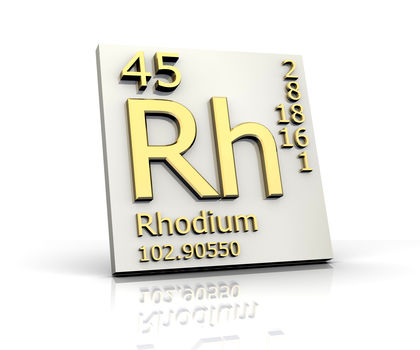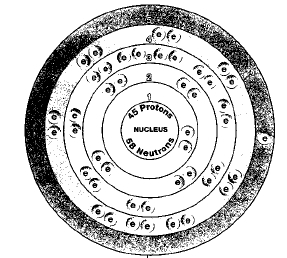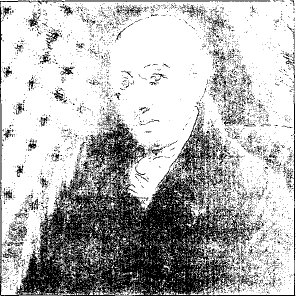RHODIUM


Overview
Rhodium is considered to be a precious metal. A precious metal is one that is rare and valued. Other precious metals are gold, silver, and platinum. Rhodium is also classified as a member of the platinum group of metals. The platinum group includes five other metals that often occur together in nature: ruthenium, palladium, osmium, iridium, and platinum.
Rhodium falls in the center of the periodic table. The periodic table is a chart that shows how chemical elements are related to one another. Elements in groups 3 through 14 are called the transition elements.
Rhodium was discovered by English chemist and physicist William Hyde Wollaston (1766-1828) in about 1804. He discovered the metal in an ore that apparently came from South America. The rhodium compound he first discovered was a beautiful rose color.
SYMBOL
Rh
ATOMIC NUMBER
45
ATOMIC MASS
102.9055
FAMILY
Group 9 (VIIIB)
Transition metal;
platinum group
PRONUNCIATION
RO-dee-um
Rhodium is used primarily to make alloys with other metals. These alloys are used for specialized industrial purposes and in jewelry.
Discovery and naming
In the early 1800s, Wollaston was studying an ore of platinum. Although scientists don't know for sure, they believe the platinum ore came from South America. Wollaston analyzed the ore and found that he could produce a beautiful rose-colored compound from it. He showed that the pink compound contained a new element. Wollaston suggested the name rhodium for the new element because of this rose color. The Greek word for rose is rhodon.
Physical properties
Rhodium is a silver-white metal. It has a melting point of 1,966°C (3,571°F) and a boiling point of about 4,500°C (8,100°F). Its density is 12.41 grams per cubic centimeter. Two of the metal's special properties are its high electrical and heat conductivity. That means that heat and electricity pass through rhodium very easily.
Chemical properties
Rhodium is a relatively inactive metal. It is not attacked by strong acids. When heated in air, it combines slowly with oxygen. It also reacts with chlorine or bromine when very hot. It does not react with fluorine, an element that reacts with nearly every other element.
Occurrence in nature
Rhodium is one of the rarest elements on Earth. Its abundance is estimated to be 0.0001 parts per million. That would place it close to the bottom of the list of elements in terms of abundance. Compounds of rhodium are usually found in combination with platinum and other members of the platinum group. Its most common ores are rhodite, sperrylite, and iridosmine.
The first rhodium compound was a beautiful rose color.
Isotopes
Only one naturally occurring isotope of rhodium is known, rhodium-103. Isotopes are two or more forms of an element. Isotopes differ from each other according to their mass number. The number written to the right of the element's name is the mass number. The mass number represents the number of protons plus neutrons in the nucleus of an atom of the element. The number of protons determines the element, but the number of neutrons in the atom of any one element can vary. Each variation is an isotope.

Rhodium also has a number of radioactive isotopes. A radioactive isotope is one that breaks apart and gives off some form of radiation. Radioactive isotopes are produced when very small particles are fired at atoms. These particles stick in the atoms and make them radioactive.
None of the isotopes of rhodium have any commercial or other use.
Extraction
Rhodium is usually obtained as a by-product in the recovery of platinum from its ores. Rhodium is separated by a series of chemical and physical reactions from other platinum metals with which it occurs. The mixture of metals is treated with various acids and other chemicals that dissolve some metals, but not others. Rhenium is one of the first metals to be removed from such a mixture.
The cost of pure rhodium was $25 per gram ($600 per troy ounce) in 1997. It cost approximately ten times that in 1991.
Uses
Most of the rhodium metal sold in the United States is used to make alloys. An alloy is made by melting and mixing two or more metals. The mixture has properties different from those of the individual metals. Rhodium is often added to platinum to make an alloy. Rhodium is harder than platinum and has a higher melting point. So the alloy is a better material than pure platinum.
Most rhodium alloys are used for industrial or research purposes, such as laboratory equipment and thermocouples. A thermocouple is a device for measuring very high temperatures. Rhodium alloys are also used to coat mirrors and in search-lights because they reflect light very well.
Compounds
Compounds of rhodium are used as catalysts. A catalyst is a substance used to speed up or slow down a chemical reaction without undergoing any change itself.
Health effects
There are no studies of the health effects from rhodium or its common compounds. Elements without information about toxicity are usually treated as if they are poisonous.
Thank you